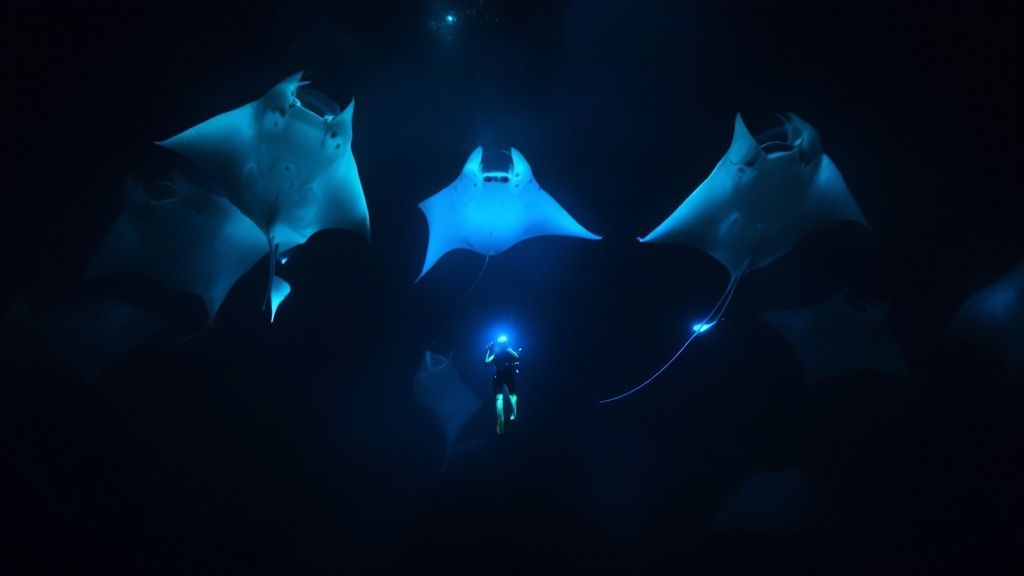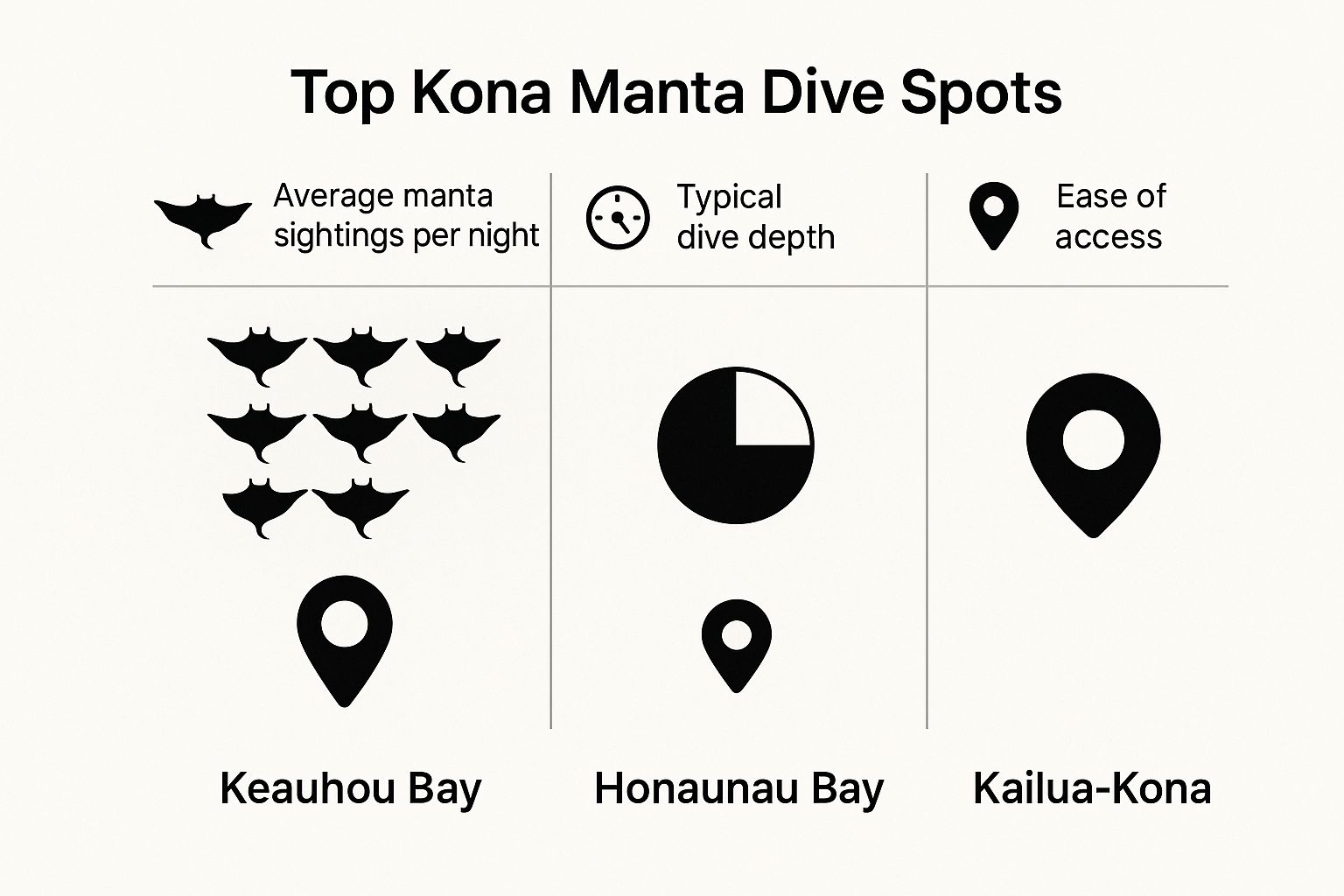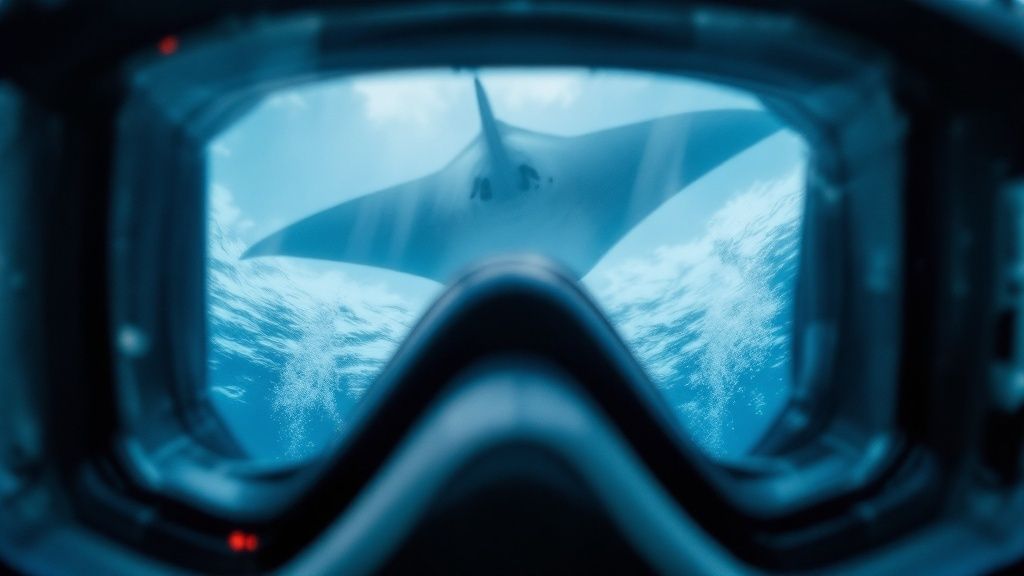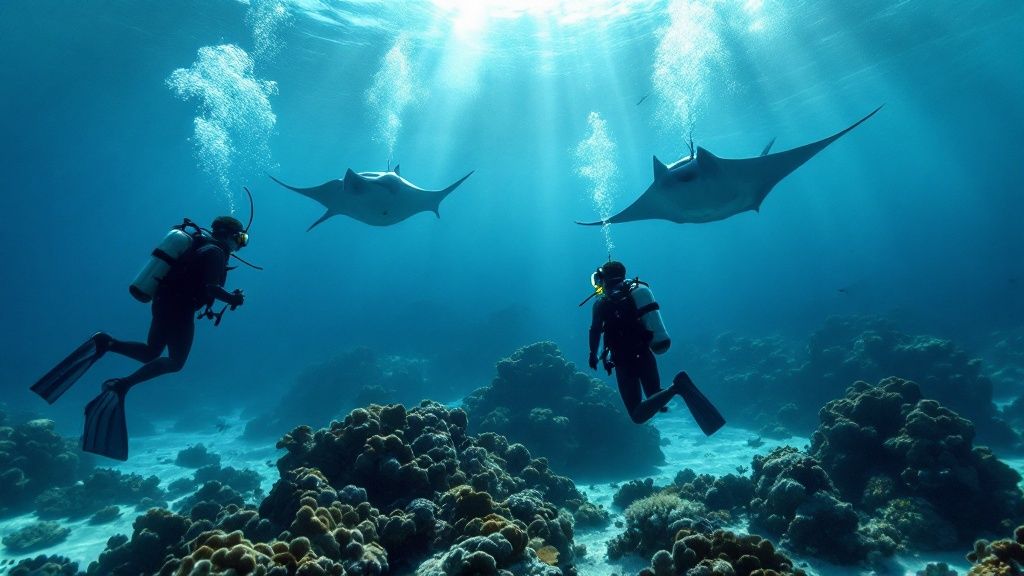Why Kona Delivers The World's Best Manta Ray Encounters
Kona, Hawaii, isn't just a popular manta ray viewing destination; it's world-renowned. What sets the Kona Coast apart? It's a unique blend of environmental factors creating a perfect haven for these gentle giants.
One key element is the underwater topography. Volcanic slopes and ocean currents combine to create concentrated pockets of plankton, the manta ray's main food source. This acts like a dinner bell, attracting mantas to predictable feeding grounds nightly.

The water temperature and nutrient-rich currents also enhance Kona's appeal. These conditions promote thriving plankton blooms, ensuring a readily available food supply. This helps explain Kona's resident population of over 450 individual manta rays.
Encounters aren't just likely; they're practically guaranteed. Manta ray sighting success rates are between 80% and 90%. This makes Kona a premier destination, attracting around 80,000 participants annually. For more detailed statistics, check out the Jack's Diving Locker Manta Ray Report.
The Role of Kona's Volcanic Landscape
Kona's volcanic history shaped the ideal manta ray habitat. The volcanic rock formations provide shelter and essential cleaning stations. Shallow, protected bays, like "Manta Village," act as natural plankton traps.
This predictable food source makes these locations prime manta ray gathering spots. This provides divers and snorkelers with unparalleled viewing opportunities.
Optimal Depth and Visibility
Optimal depth conditions in Kona contribute to exceptional visibility during dives. These clear waters allow for extended viewing and closer interactions with the manta rays, maximizing the experience. This combination creates a near-perfect environment for both manta rays and those who come to see them.
Manta Heaven vs Manta Village: Which Site Delivers
Choosing the right manta dive site in Kona can significantly impact your experience. Two popular spots, Manta Heaven and Manta Village, offer unique viewing opportunities. Deciding which one is best for you depends on your expectations and diving experience.
Understanding the Key Differences
Manta Heaven, also known as Garden Eel Cove, is located north of Kona International Airport. This site is known for potentially larger groups of manta rays, sometimes creating a truly breathtaking spectacle. You can find more information about Manta Heaven at Kona Honu Divers. However, due to its location, conditions can be more challenging.
Manta Village is situated south of Kona in Keauhou Bay. It is renowned for its calmer waters and consistently high manta ray sighting rates. While you may see fewer mantas at one time compared to Manta Heaven, the chance of an encounter is exceptionally high. This makes it ideal for beginners and those seeking a more predictable experience. For those interested in Kona snorkeling experiences, check out the Manta Ray Kona Snorkel.
Both Manta Heaven and Manta Village play a crucial role in ongoing manta ray research along the Kona Coast. Dedicated research efforts at these sites have documented detailed records of manta sightings. This provides valuable data about these gentle giants. You can learn more about this important research from the Manta Ray Advocates.
The following infographic helps visualize the differences between Keauhou Bay (Manta Village), Honaunau Bay, and Kailua-Kona. It compares average manta sightings, typical dive depths, and ease of access.

This infographic compares Keauhou Bay (Manta Village), Honaunau Bay, and Kailua-Kona, visualizing average manta sightings, typical dive depth, and ease of access.
As the infographic demonstrates, Keauhou Bay has a high average number of manta ray sightings per night. Combined with its moderate dive depth and easy access, it’s easy to see why it is so popular, especially with newer manta divers.
To further compare Manta Heaven and Manta Village, let's look at a detailed comparison table. This table provides a side-by-side overview of key features, including average depth, typical conditions, and the best diving times.
| Feature | Manta Heaven | Manta Village |
|---|---|---|
| Average Depth | 30-40 feet | 20-30 feet |
| Typical Conditions | Can be variable; sometimes choppy | Generally calm and clear |
| Best Diving Times | Night dives | Night dives |
| Manta Ray Sightings | Potential for larger groups | Consistently high sighting rates |
| Experience Level | More suitable for experienced divers | Ideal for beginners |
As you can see, Manta Village stands out for its calmer conditions and consistent sightings, while Manta Heaven offers the potential for larger manta gatherings.
Choosing the Right Site for You
Both Manta Heaven and Manta Village offer incredible manta ray encounters. The "best" choice truly depends on your priorities.
-
For Beginners: Manta Village offers calmer waters and high sighting rates, making it an excellent starting point.
-
For Experienced Divers: Manta Heaven may present more dynamic encounters with larger groups of manta rays, though it may require more advanced skills due to potentially variable conditions.
-
For Photography Enthusiasts: Both locations offer excellent photo opportunities. However, the clearer, calmer waters of Manta Village often provide better visibility.
Ultimately, consider your comfort level in the water, your diving experience, and what you hope to get out of your Kona manta ray dive adventure. No matter which site you choose, preparing yourself with the right knowledge and equipment will contribute to an unforgettable experience.
Finding Dive Operators Who Actually Care About Your Experience
Not all manta dive Kona operators are the same. Your choice significantly impacts this incredible experience. This section reveals the key factors separating exceptional operators from the rest.
Key Questions to Ask Potential Operators
Before booking your manta dive Kona adventure, asking the right questions is essential. This helps determine the operator's commitment to both your experience and the manta rays' well-being.
- Safety Protocols: Inquire about their safety record, emergency procedures, and staff certifications. Reputable operators prioritize diver safety.
- Group Size: Smaller groups offer a more personalized experience and minimize disturbance to the manta rays. Ask about the typical diver-to-guide ratio.
- Guide Expertise: Knowledgeable guides enhance your experience. They understand manta ray behavior and dive site conditions. Ask about their experience with the local manta ray population.
- Sustainability Practices: Responsible operators protect the marine environment. Ask about their sustainable tourism practices and how they minimize their impact on the manta rays and their habitat.
Evaluating Track Records and Included Services
Further research into the operator's background and offerings is key. This includes understanding their experience and what your booking includes.
- Track Record: Online reviews and testimonials offer valuable insights. Positive feedback from previous divers indicates a quality operator.
- Included Services: Understand what's included: equipment rental, wetsuits, snacks, drinks, and transportation. Transparency is a good sign.
- Equipment Quality: The equipment's condition affects your comfort and safety. Inquire about the quality and maintenance of their dive gear and boats.
- Post-Dive Support: Exceptional operators offer post-dive assistance, such as help with underwater photography or identification resources. Learn more in our article about Kona Manta Ray Night Dive.
Recognizing Operators Who Prioritize Your Experience
Outstanding manta dive Kona operators create unforgettable experiences.
- Personalized Attention: Look for operators who offer small groups, individual attention, and genuine interest in your enjoyment.
- Boat Conditions: Comfortable seating, hot showers, and refreshments enhance your time on board. Consider these amenities.
- Passion for Manta Rays: An operator's passion for manta rays and conservation enriches your experience. You might be interested in: Why should you go on a Manta Ray Dive in Kona?

By considering these factors and asking the right questions, you'll choose an operator who values your experience and the well-being of these magnificent creatures. This ensures a memorable underwater adventure.
Your Night Dive Reality Check: What Actually Happens
Forget the glossy brochures; let's talk about what a manta ray night dive in Kona really looks like, from start to finish. We'll walk you through every step, from the pre-dive briefing to that incredible moment when these gentle giants, with wingspans reaching up to 12 feet, appear as if from nowhere. Want more background information on manta ray night dives? Check out this helpful resource: What is Manta Ray Night Dive?
The Pre-Dive Briefing: Your Safety First
Your adventure begins with a thorough safety briefing. This is an essential part of the experience, crucial for a safe and enjoyable dive. Experienced guides will cover dive procedures, hand signals, and the importance of responsible interaction with the manta rays. They'll also review equipment use and emergency protocols, making sure everyone feels comfortable and prepared.
Entering the Water and Positioning Yourself
After the briefing, you'll enter the water and get into position, which will depend on whether you're snorkeling or diving. Snorkelers generally hold onto a floating board equipped with lights, while divers settle on the ocean floor. These strategically placed lights attract plankton, the manta rays' main food source, setting the stage for an amazing natural light show. The popularity of these dives is due to the truly unique experience offered by Kona's nighttime manta ray encounters. The local tourism industry supports not only the Kona economy but also contributes to global manta ray conservation efforts. Learn more about this important connection: Manta Ray Tourism and Conservation.
The Manta Ray Ballet: A Feast for the Senses
Get ready to be amazed when the manta rays arrive. These graceful creatures perform an underwater ballet, gliding and looping through the water as they feed on the plankton. They often come remarkably close, sometimes just inches from your mask, offering a truly breathtaking and unforgettable experience. This is a remarkable opportunity to witness the wonders of nature firsthand.
Dive Duration and Post-Dive Experience
A typical manta ray dive in Kona lasts approximately 45 minutes to an hour. Once back on the boat, you can warm up, share stories with your fellow divers, and relive the magic of the encounter. Many dive operators provide hot drinks and snacks, offering a comforting conclusion to an extraordinary evening.
Photography Tips for Low-Light Conditions
Capturing this magical experience requires a bit of planning. Be sure to adjust your camera settings for low-light conditions. A red filter can enhance the colors in your photos. Patience is key. Wait for the perfect moment to capture a stunning image of these graceful giants. This will allow you to preserve your memories and share this incredible experience with others.
Essential Prep That Prevents Disappointment
Proper preparation is the key to an unforgettable manta ray dive in Kona. Understanding the physical requirements, the essential gear, and how to manage any potential anxieties will significantly enhance your adventure. You might be interested in: Why should you go on a Manta Ray Dive in Kona?

Physical Requirements and Swimming Skills: Beyond the Basics
While dive operators typically don't list strict physical requirements, a reasonable comfort level in the water is essential. You should be able to comfortably tread water or float for extended periods, particularly if you're snorkeling.
Some basic swimming skills, like efficient finning, will improve your maneuverability, allowing you to fully enjoy the experience. This is especially helpful in potentially choppy conditions.
Gear Up for Success: Essential vs. Gimmick
The right equipment maximizes comfort and minimizes distractions. A wetsuit is crucial, providing insulation and protection even in warmer months. A 3mm thickness is usually sufficient, but a 5mm suit might be better for cooler periods.
Water shoes offer foot protection and grip on the boat. For underwater photography, invest in a waterproof camera with strong low-light capabilities. Test your camera and familiarize yourself with its settings beforehand.
Overcoming Night Diving Anxiety: Practical Tips
For first-time night divers, some apprehension is normal. However, these concerns are easily managed. Communicate with your guide, as their support can significantly ease anxiety.
Focusing on slow, deep breaths helps calm nerves both before and during the dive. Remember that dive operators prioritize safety, employing established protocols and experienced guides to ensure a comfortable and secure environment.
Respectful Manta Ray Interactions: Enhancing Your Experience
Respectful interaction with the manta rays is crucial. Never attempt to touch them, as this can disrupt their protective mucous layer.
Avoid flash photography, as it can startle and disorient these gentle creatures. Listen to your guide's instructions and maintain a respectful distance. Following these guidelines contributes to a sustainable environment and a more rewarding experience for everyone.
Weather and Your Plans: Being Prepared
While Kona generally enjoys pleasant weather, wind and occasional rain can impact dive conditions. Check the forecast and pack accordingly.
Consider a light windbreaker for boat rides, as it can get chilly after being in the water. Flexibility is key. Reputable operators often offer rescheduling options if conditions aren't ideal on your chosen date.
Smart Booking: Timing, Pricing, and Getting Real Value
Planning a manta ray dive in Kona can feel overwhelming. This guide helps you understand pricing, find real value, and avoid booking mistakes. We'll cover how timing and seasonal changes affect both cost and the quality of your manta ray experience.
Decoding Pricing Structures and Package Inclusions
Manta dive prices in Kona depend on several factors. These include the tour operator, the type of dive (snorkeling or scuba diving), and whether you opt for a group tour or a private charter. It’s important to understand what each package includes. Some operators include equipment rentals, wetsuits, and refreshments, while others offer these as add-ons. Don't be drawn in by low prices that don't cover the essentials.
Seasonal Variations: Impact on Price and Manta Activity
Peak season (summer) often has higher prices because of pleasant weather and high demand. This period usually offers calmer waters and excellent visibility. Off-season (winter) might have lower prices. However, rougher seas and potential tour cancellations are more likely. Consider these trade-offs when making your plans.
Optimal Booking Timeframes for Better Rates
Booking ahead, especially during peak season, is key to securing your preferred dates and times. Some operators provide early bird discounts or online booking promotions. Traveling mid-week or during the shoulder seasons (spring and fall) can also offer potential savings and fewer crowds.
Lunar Cycles and Dive Conditions: Planning Around the Moon
Lunar cycles impact plankton visibility, which in turn influences manta ray activity. Nights with a new moon are generally best for night dives. The minimal moonlight enhances plankton visibility, making it easier for manta rays to feed.
Money-Saving Strategies and Group Booking Advantages
Look for ways to save money, like group discounts or package deals that combine dives with other activities. Traveling with a group can often lead to substantial savings per person.
To help you plan your trip, we've compiled a handy table summarizing the best times to dive with manta rays throughout the year. It details monthly manta ray activity, weather conditions, and recommended diving times.
Seasonal Manta Diving Guide
Monthly breakdown of manta activity levels, weather conditions, and optimal diving times throughout the year
| Month | Manta Activity | Weather Conditions | Recommended |
|---|---|---|---|
| January | Moderate | Variable | Day |
| February | Moderate | Variable | Day |
| March | Increasing | Improving | Day/Night |
| April | High | Good | Day/Night |
| May | High | Good | Day/Night |
| June | High | Excellent | Day/Night |
| July | High | Excellent | Day/Night |
| August | High | Excellent | Day/Night |
| September | High | Excellent | Day/Night |
| October | High | Good | Day/Night |
| November | Moderate | Variable | Day |
| December | Moderate | Variable | Day |
As the table shows, the summer months offer the most consistent manta ray sightings paired with ideal weather. While other months still provide opportunities, be prepared for more variable conditions.
Realistic Budget Planning and Timing Recommendations
Plan your budget considering the average cost of manta ray dive tours in Kona, which typically ranges from $100 to $250 or more, depending on the experience. Factor in extras like equipment rental or tips. Choose your travel dates based on your budget and preferred dive conditions, taking into account weather, manta ray activity, and pricing.
How Your Dive Supports Manta Ray Conservation
Your manta ray dive in Kona isn't just a personal thrill; it's a direct contribution to essential conservation efforts. By choosing to dive responsibly, you become part of a larger movement, protecting these magnificent creatures for future generations.
Responsible Tourism: A Win-Win
Responsible dive tourism plays a vital role in manta ray protection. The revenue generated from manta dives supports research programs dedicated to understanding these gentle giants. It also funds educational initiatives that raise awareness about the importance of manta conservation. This creates a sustainable cycle where tourism fuels conservation, and conservation enhances the tourism experience. Manta ray advocacy and conservation benefit significantly from Kona's robust tourism industry, with snorkeling and diving attracting numerous visitors. The economic impact of these tours is substantial, driven by the high demand for manta ray encounters. Discover more insights about manta ray tourism in Kona.
Kona's Conservation Model
Kona's approach to manta ray conservation serves as a model for other destinations. The established guidelines and regulations, developed with scientists and local operators, ensure sustainable interactions. Strict protocols against touching the manta rays, for example, protect their sensitive skin and prevent disease transmission. This focus on minimal impact ensures the long-term health of the manta ray population and the continued success of manta dive tourism. You might also be interested in learning the best time of year to see manta rays in Kona.
Contributing Beyond the Dive
Individual divers can also make a big difference. By adhering to responsible diving practices, you directly contribute to conservation. This includes:
- Avoiding touching the manta rays
- Maintaining a respectful distance
- Following your guide's instructions
You can further contribute by supporting organizations dedicated to marine conservation. When planning your manta dive, explore various payment options to make it more accessible. Some operators offer flexible payment plans. Your actions, both in and out of the water, contribute to the well-being of these incredible animals. Book your manta ray dive with Kona Honu Divers today and be a part of our conservation efforts!
